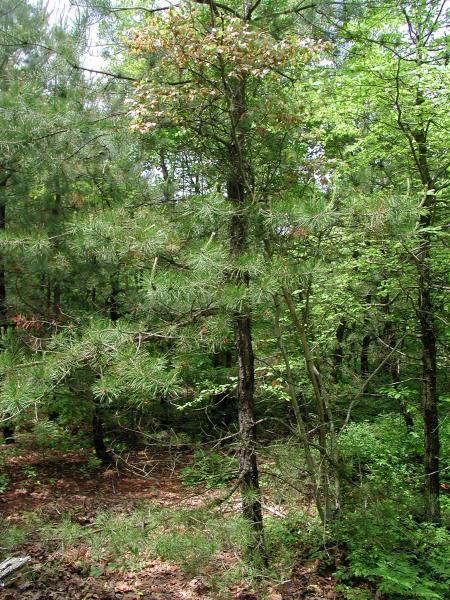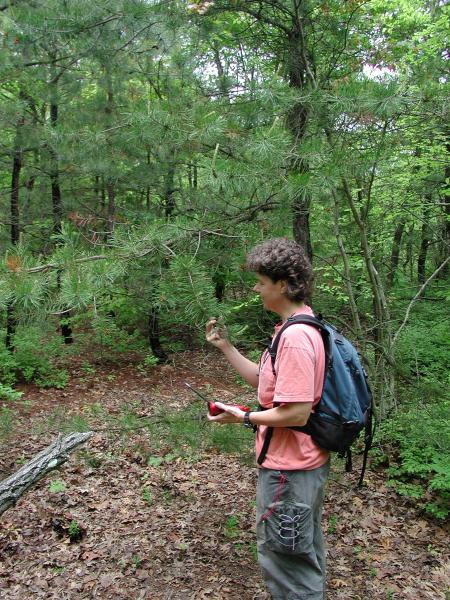Short-leaved Pine
Pinus echinata P. Mill.
- Class
- Pinopsida (Conifers)
- Family
- Pinaceae (Pine Family)
- State Protection
- Endangered
Listed as Endangered by New York State: in imminent danger of extirpation in New York. For animals, taking, importation, transportation, or possession is prohibited, except under license or permit. For plants, removal or damage without the consent of the landowner is prohibited.
- Federal Protection
- Not Listed
- State Conservation Status Rank
- S1
Critically Imperiled in New York - Especially vulnerable to disappearing from New York due to extreme rarity or other factors; typically 5 or fewer populations or locations in New York, very few individuals, very restricted range, very few remaining acres (or miles of stream), and/or very steep declines.
- Global Conservation Status Rank
- G5
Secure globally - Common in the world; widespread and abundant (but may be rare in some parts of its range).
Summary
Did you know?
This pine is named for the spiny bracts on the outside of the cones. It is well adapted to fire because its crook-shaped lower trunk sends up new shoots if the upper trunk is killed by fire (Wikipedia contributors).
State Ranking Justification
There is one small existing population. There were four populations from the late 1800s that no longer exist because their habitat has been eliminated but there's still one record from 1915 on Long Island that needs to be rechecked.
Short-term Trends
The short-term trend of the existing population is apparently stable.
Long-term Trends
This plant has always been very rare but populations have been reduced from the 1800s from 5 locations to one.
Conservation and Management
Threats
Trees may be suppressed by shading from taller surrounding vegetation if open-canopied conditions are lost.
Conservation Strategies and Management Practices
Maintain open-canopied conditions around the trees to allow the trees space to grow and reproduce.
Habitat
Habitat
The trees grow along the sandy trails and at the bottom of a sandy berm in wet deciduous woods (New York Natural Heritage Program 2012).
Associated Ecological Communities
- Red maple-blackgum swamp
(guide)
A maritime, coastal, or inland hardwood swamp that occurs in poorly drained depressions, sometimes in a narrow band between a stream and upland. Red maple and blackgum are often codominant or blackgum may be the dominant tree. Pitch pine may occur on drier hummock islands in pine barrens settings.
- Red maple-sweetgum swamp
(guide)
A hardwood swamp that occurs on somewhat poorly drained seasonally wet flats, usually on somewhat acidic soils. Red maple-sweetgum swamps often occur as a mosaic with upland forest communities. Sweetgum is often the dominant tree or may be codominant with red maple. Other codominant trees include pin oak and blackgum.
Associated Species
- Acer rubrum
- Betula populifolia (gray birch)
- Eupatorium torreyanum (Torrey's thoroughwort)
- Lespedeza
- Liquidambar styraciflua (sweet-gum)
- Myrica pensylvanica
- Phragmites australis (old world reed grass, old world phragmites)
- Quercus alba (white oak)
- Quercus rubra (northern red oak)
- Sassafras albidum (sassafras)
- Solidago
- Vaccinium corymbosum (highbush blueberry)
Range
New York State Distribution
Currently this pine is only known from Staten Island. The one historical population in Suffolk County is considered extirpated. There are also a few records of planted trees in Essex and Nassau counties and unconfirmed reports from Albany and Westchester counties.
Global Distribution
It is widespread throughout the southeastern US from New Jersey southeast to Missouri, Eastern Oklahoma and eastern Texas. It is scattered and rare from eastern Pennsylvania to Staten Island.
Identification Comments
General Description
Shortleaf pine is a medium tall tree with a short crown. The bark is reddish-brown (almost black when young), furrowed, and broken into large, scaly plates. The twigs are pale and whitish. The needles are usually 2 per bundle but sometimes 3. They are 7.5-12 cm long, slender, soft and flexible, sharp pointed, yellowish-green to dark bluish-green. The cones are oblong and taper near the tip, 3.8-6.3 cm long and dull brown. The scales have a sharp spine in the middle. They open at maturity and persist for several years (Gleason and Cronquist 1991).
Best Life Stage for Proper Identification
This pine can be identified at any time of the year.
Similar Species
Virginia pine looks very similar but its leaves are always two per bundle and 4-7 cm long (yes, shorter than those of shortleaf). The twigs are purplish brown or purplish gray waxy. The cone may be a little more reddish (Gleason and Cronquist 1991).
Best Time to See
The trees and their persistent cones are visible any time of year.
- Vegetative
- Fruiting
The time of year you would expect to find Short-leaved Pine vegetative and fruiting in New York.
Short-leaved Pine Images
Taxonomy
Short-leaved Pine
Pinus echinata P. Mill.
- Kingdom Plantae
- Phylum Coniferophyta
- Class Pinopsida
(Conifers)
- Order Pinales
- Family Pinaceae (Pine Family)
- Order Pinales
- Class Pinopsida
(Conifers)
- Phylum Coniferophyta
Additional Common Names
- Shortleaf Pine
- Yellow Pine
Additional Resources
Best Identification Reference
Flora of North America Editorial Committee. 1993. Flora of North America, North of Mexico. Volume 2. Pteridophytes and Gymnosperms. Oxford University Press, New York. 475 pp.
Other References
Elias, Thomas S. 1980. The Complete Trees of North America Field Guide and Natural History. Van Nostrand Reinhold Co., New York, New York. 948 p.
Fernald, M.L. 1950. Gray's manual of botany. 8th edition. D. Van Nostrand, New York. 1632 pp.
Gleason, Henry A. and A. Cronquist. 1991. Manual of Vascular Plants of Northeastern United States and Adjacent Canada. The New York Botanical Garden, Bronx, New York. 910 pp.
Holmgren, Noel. 1998. The Illustrated Companion to Gleason and Cronquist's Manual. Illustrations of the Vascular Plants of Northeastern United States and Adjacent Canada. The New York Botanical Garden, Bronx, New York.
Little, E.L., Jr. 1979. Checklist of United States trees (native and naturalized). Agriculture Handbook No. 541. U.S. Forest Service, Washington, D.C. 375 pp.
New York Natural Heritage Program. 2010. Biotics database. New York Natural Heritage Program. New York State Department of Environmental Conservation. Albany, NY.
New York Natural Heritage Program. 2024. New York Natural Heritage Program Databases. Albany, NY.
Rhoads, Ann F. and Timothy A. Block. 2005. Trees of Pennsylvania. A Complete Reference Guide. University of Pennsylvania Press, Philadelphia, PA.
Weldy, T. and D. Werier. 2010. New York flora atlas. [S.M. Landry, K.N. Campbell, and L.D. Mabe (original application development), Florida Center for Community Design and Research http://www.fccdr.usf.edu/. University of South Florida http://www.usf.edu/]. New York Flora Association http://newyork.plantatlas.usf.edu/, Albany, New York
Links
About This Guide
This guide was authored by: Stephen M. Young
Information for this guide was last updated on: September 6, 2012
Please cite this page as:
New York Natural Heritage Program. 2024.
Online Conservation Guide for
Pinus echinata.
Available from: https://guides.nynhp.org/shortleaf-pine/.
Accessed July 26, 2024.


